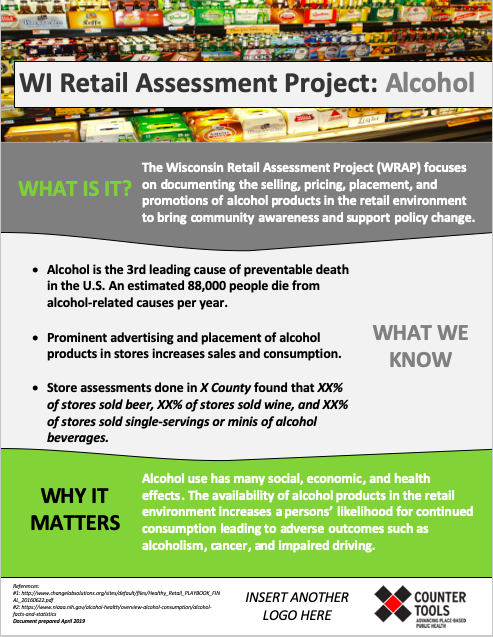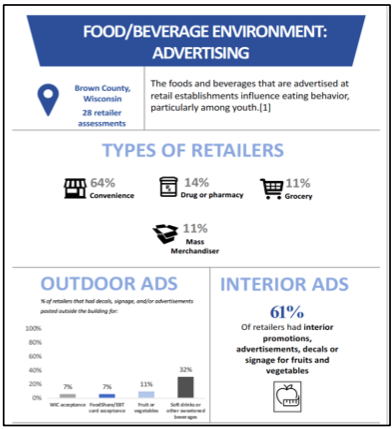Project Description
Overview
Since 2016, Counter Tools has partnered with the Wisconsin Department of Health Services (WI-DHS) to assist with data collection, provide understanding of data/trends, and support change related to tobacco, alcohol and food products in the retail environment. The retail environment affects what products people have access to and their resulting behaviors. Data collected about the retail environment can be used to raise awareness and assist with identifying targeted solutions to curb the impact of unhealthy products on populations.
For food and alcohol specifically, Wisconsin has taken a proactive approach by gathering evidence on these products, doing community education, and exploring solutions for increasing healthy options within communities.
Background
 Research shows us that retailer density and proximity, as well as product availability, promotions and pricing in the retail environment, all have the potential to influence consumer purchasing behaviors.
Research shows us that retailer density and proximity, as well as product availability, promotions and pricing in the retail environment, all have the potential to influence consumer purchasing behaviors.
The availability of unhealthy food and beverage products in the retail environment can lead to greater rates of disease and disability including obesity, cardiovascular disease and diabetes. Even more, a high availability of alcohol outlets has been associated with increased rates of excessive drinking, underage use, and crime. Restricting the availability and advertising of alcohol in stores can reduce some of these negative impacts. In a similar vein, when stores are able to stock and advertise healthy products (like fruits and vegetables) and have them clearly visible and accessible, people are able to make better choices.
WI-DHS implemented the Wisconsin Retail Assessment Project (WRAP) annually, from 2016-2019, to document the advertising for and availability of tobacco, alcohol and food products in the state. This project was supported by state-level leaders, coalition coordinators, and volunteers. Some goals of WRAP were to increase knowledge about the retail environment, identify disparities, foster community awareness, and build public support towards interventions.

In 2016, WRAP started with a pilot in Milwaukee that focused on the tobacco retail environment in select zip code clusters. After this initial pilot, the project expanded to include additional counties across the state. In addition, food and alcohol data was collected and incorporated into the project.
Before and through WRAP, Wisconsin saw an opportunity to increase local knowledge of the retail environment by identifying what products were being marketed and sold in stores, determine differences in access between geographic areas, figure out strategies to increase healthy options, and change the retail landscape of communities within the state.
Strategy
Coalitions participating in WRAP were tasked with assessing stores/retailers through completing store assessments. Hundreds of licensed stores/retailers were assessed across the state from 2017 – 2019 as part of the data collection process for food and alcohol. Most of the assessments were completed at convenience stores.
For these assessments, a survey form was used to gather information on product availability, advertising, and placement. Counter Tools worked with Wisconsin to develop this survey form and programmed this form into its online data collection tool. By collecting data electronically, the coalitions were able to complete the same survey form, for each retailer, efficiently and accurately. Because of this, data was able to be easily analyzed over time.
“Before partnering with Counter Tools, our coalitions were using different data collection forms, there was no uniformity resulting in inconsistent data.”
To have an accurate list of stores/retailers to visit, changes to them (e.g., closures, openings) were crowdsourced by coalitions over time. In 2019, the statewide list of licensed stores/retailers was cleaned and standardized by Counter Tools to also aid in the effort for a comprehensive and accurate retailer list for use by the coalitions.
In addition to providing technical assistance throughout the data collection process, Counter Tools analyzed the assessment data at both the county and state-level. Using this data, Counter Tools created infographics and factsheets for food and alcohol. These materials were presented in easy-to-read formats that the coalitions could share with community members, decision-makers, and other stakeholders to raise awareness about the importance of a healthy retail environment.


Results
Wisconsin found that better understanding the retail environment, using the assessment data collected to identify specific areas for change, increasing community awareness, and starting conversations with stores were effective strategies in moving things forward.
 For example, store assessments found that a low percentage of stores in Wisconsin were selling dried fruit compared to other types. Dried fruit is more shelf stable than fresh fruit and may be easier for a store to stock. Dried fruit can also be advertised as a portable, grab-and-go snack. By using data points like this, to talk with store owners directly, a tangible strategy can then be offered to increase healthy options available like dried fruit.
For example, store assessments found that a low percentage of stores in Wisconsin were selling dried fruit compared to other types. Dried fruit is more shelf stable than fresh fruit and may be easier for a store to stock. Dried fruit can also be advertised as a portable, grab-and-go snack. By using data points like this, to talk with store owners directly, a tangible strategy can then be offered to increase healthy options available like dried fruit.
There are also opportunities for improvement that might not require major changes or huge financial commitments to implement. For example, the assessment data showed that some stores in the state were less likely to display their fruits and vegetables in prominent locations, including near cash registers. A potential solution/change for this could be in moving these products to be more visible, which could cause shoppers to be more likely to purchase these healthy options.
Many areas in the state have used the assessment data they collected to make way for change in their communities. As an example, advocates in Milwaukee have made strides in sharing data and engaging with community members. To aid in this, the communication materials (infographics and factsheets) created by Counter Tools have been used for community education purposes. Also, targeted webinars were conducted to share data, research, recommendations, and best practices with the public. Most recently, in late 2020, Milwaukee leaders facilitated two webinars to discuss rates/impacts of alcohol consumption and healthy/unhealthy food access, with Counter Tools presenting information on why the retail environment (or point-of-sale) matters and potential solutions.
Using the resources and knowledge at their disposal, areas like Milwaukee are working on ideas for moving forward to reduce the impact of unhealthy products by encouraging action to be taken and getting communities on board for change.
Highlight
The Healthy Food Marketing Collaborative in Chippewa Valley is a great example of a local success story. A CDC grant funded this collaborative from 2016 – 2018 to support efforts to improve healthy food access at small retail stores in underserved areas of their communities. In total, the Healthy Food Marketing Collaborative worked with 12 stores across the Eau Claire/Chippewa/Dunn tri-county region in Wisconsin.
After examining assessment data, the collaborative worked with each store manager to develop personalized strategies for improvement. The collaborative found this one-on-one technical assistance to be the key to success. With the available funding, the collaborative was able to purchase items for the stores, such as fruit baskets, small refrigerated coolers, and shelf signage. The collaborative offered training to the managers on stocking healthy options and utilizing new selling strategies. The collaborative also helped advertise successes with media outreach, sharing online, and through press releases.
As an example of progress, here are “before” and “after” photos of a small convenience store in Dunn County. Shelving in a prime location near the cash register that held candy and other miscellaneous items was replaced with fruit and vegetable baskets.
Before:

After:

“The collaborative has served as a model for other communities throughout Wisconsin, sharing specifics about their strategies, what they purchased, and how they worked closely with store managers. Their work has had an impact beyond their tri-county region.”
Next Steps
Wisconsin continues to work towards improvements in the retail environment related to food and alcohol. Advocates, coalition members and those alike regularly share data in communities, consider potential solutions, build relationships with local stores, and lead efforts to address disparities in the marketing and availability of food and alcohol products.
To further guide the efforts across the state, Wisconsin has a set of recommendations that are connected through their State Health Improvement Plan, entitled Healthy Wisconsin. This plan identifies challenges and goals for addressing the priorities of tobacco, nutrition, physical activity, alcohol, opioids, suicide and Adverse Childhood Experiences (ACEs).
The concerted efforts under WRAP have helped to build momentum for creating healthier retail environments across the state. Wisconsin provides a good example of the importance of collecting data about the retail environment, having cross-sector collaboration in efforts, and increasing access to healthy products for the betterment of population health.
Published February 11, 2021

